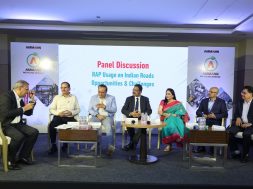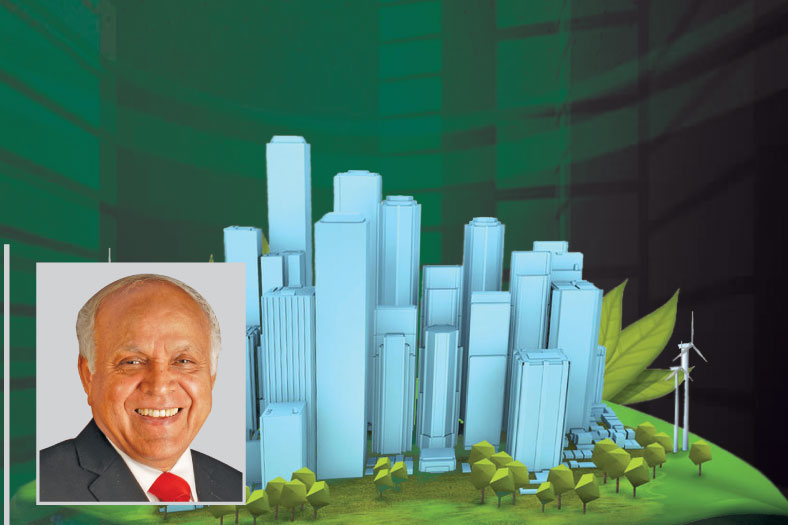Good artist not necessarily good architect: Ar Porwal
Good artist not necessarily good architect: Ar Porwal“We are not commercial people; we are here to serve the society rather than just making money,” emphasises Sanjay Porwal, Principal Architect, Kalayojan ArchitectsArchitecture is an art. It’s not just planning or drawing something. It’s more than that; it’s science, humanity and understanding of environment. In an exclusive interview with ACE Update, Sanjay Porwal shares his ideologies as well as the importance of using head to think how to achieve what our heart is thinking.Architecture sector has evolved over the years. What are the new trends you are witnessing?Whether the architectural sector has evolved is a question mark itself. There is some change, but whether the change is good or bad that we need to ask ourselves. What I do understand from the sector is that people are just drawing lines. What is missing is logic and approach. Actually, most of the work, which is going, is playing to the galleries, rather than being satisfied by their own work.What should be done to change the scenario?I think that steps have to be taken at college level and students have to be trained for good architecture. What’s missing is inspiring people coming and talking to them. There are seminars and guest lecturers coming and speaking to them. Also, college principals and professors need to be visionaries who can inculcate good education at the college level itself.With space crunch in cities, is going vertical the only solution?Going vertical is not the only solution; we all know that actually. When it becomes inevitable, you go vertical. What is happening that we are not taking care of horizontal development. We only look at vertical, and it’s only one option rather than total inclusive solution. Unfortunately, there are no steps taken to go horizontal.There is no policy toward the horizontal development; that policy is lacking. Look at our building rules and regulations, there is nothing like an urban commission. I suppose rules are pre-framed by non-architects. And there is no participation of good vision like what I would say is some known architects should be involved in framing the policies for the city, which is now entirely lacking. When mills were closing down, they had the Charles Correa committee, and he gave very simple solution — 33 per cent for residential building, 33 per cent commercial building and 33 per cent open space — but it never materialised. Finally, builders were overpowered, and foreign investment, which has come, has destroyed our city.Does association of architects have taken any step to change the scenario?I must say, unfortunately no, and whatever meetings are being conducted at architect level or PEATA level, no one is taking the issues seriously to the level of framing policies and influencing government to frame the policies. Even the seminars have become money making business; they call speakers who pay directly or indirectly. Most of the seminars are held by organisers who are professionally involved into conducting seminars to make money. So they want exhibitors and speakers who will pay the money. Even the audience has to pay. Everything has become commercial. Actual thoughts are not taken home; it has just become place of networking meetings and drawing business from each other, rather than coming with the right solutions.According to you, what should be done to change the scenario?Each architect has to work honestly from their studio. It is very important. We are not commercial people; we are here to serve the society rather than just making money. We have to give better opportunity for people to live and work in good atmosphere.While designing a building or structure, what points should be kept in mind?Each building is designed for a function. People are designing the building first and let function follow the form. When building stands for a particular function, it is not standing in isolation. It is standing there in neighbourhood of other buildings, or it has a context of the geographical location of the building. It has context of historical and cultural location of that particular area and context of people who have been staying in that particular area. So there is lot of influences on particular building, it’s not that you will give me set of requirements and I design a building and say all your requirements are fulfilled and make a elevation, or I give elevation to some 3D visualises and he makes elevation and gives you building. Those kinds of products can be fancy, they can’t be timeless products.Is environment also taken into consideration while designing buildings?Well, there is too much of hue and cry about the environment these days. We have spoiled our environment and now talking about correcting it. We must make our buildings to suit the environment. The kind of projects we do, they are consciously designed keeping environment in mind. I don’t think beauty of a building even in terms of taking care of environment something which is applied over the building. The very process of designing these factors have to be taken into consideration at subconscious level. It is not something applied over the building. I don’t design building now but take environmental care; it has to be designed in that way.Environment is not something like lipstick treatment. If you design the building well, you don’t have to talk about these aspect at all, because building is part of environment. If I don’t design my building well, I am killing the environment. When we were designing VTU in Belgaum, we visited this site and told my assistants that it is such a beautiful site and I hope that I don’t destroy this site by my designs. So each project has to be designed to its context.What are the innovations happening in terms of architectural designing? There are too many innovative products, which are changing the architectural design. There is meta form in thinking in terms of shapes and art of the building. There has been time when there were art department. People nowadays don’t know in which era they are living. Consumerism is changing the shape of architect and what sells is not necessarily good.What is done to encourage young architects?What happened is that architecture is not the first choice of many people. Some people feel that it is art and not study, and they take it lightly. 60-70 per cent students are in architecture because they are forced to get into this field, so fundamentally they are not involved.Logically thinking students prefer some other fields. Architecture is not just taking something and drawing something. It’s much more to it; it’s science, humanity and understanding of environment, consciously understanding of this. It has to be foremost thing that you need art to draw and express your thoughts, but just because you are good artist that doesn’t make you’re architect.
Once the students come out of college, the first or second step which they take is very important, because that gives them direction where they have to go. For example, choosing a particular architecture office is very important. Once they choose good architect, they are moulded in a better way to think and design, to present and better way to give service which is expected by the society of an architect.Also, people who take service from the architect don’t know what service they should expect from the architect. Many a time, it happens that we are called architects but particular client thinks he knows what he wants to build and he tells to draw as per his requirement, so we are reduced to people who are making drawings and not people who understand the environment and buildings, and people don’t know what kind of work should be taken from us. These are the changes to be brought in. There should be huge seminar on what to expect from architects.You have worked with architects like Charles Correa and Uttam Jain; how has it helped shaping your career?I have worked in Urban Design Research Institute which was brainchild of Charles Correa and there I had opportunity to meet number of good architects. In fact, earlier, I worked with Prem Nath & Associates for 2 years. When I got opportunity to be with Urban Design Research Institute for 1 year, it changed my entire thought process, and we used to have meetings across the table. The seniors used to discuss ideas with us and that has good bearing on my career and that gave me different level of thinking of architecture. I was totally different pre-UDRI and post-UDRI.In the UDRI research studio, there were 10 students who had come down from Cambridge University and 10 selected students from India and I was one of the lucky student. We worked on some documentation projects and study on some areas of Mumbai. We also worked on live project in CIDCO for UDRI housing project in Sector 3 of Sanpada CIDWhich are the projects you are currently working on?We are doing some institutional projects in Karwar and Mysore as well as some projects at the VTU campus in Belgaum which is going into its fourth phase. Recently, we are involved in several redevelopment projects in Mulund.Can you tell us more about your current redevelopment projects?I have been practising from Mulund for the past 27 years, but I was working more from outside rather than working inside of Mumbai. We had taken part in several design competitions and won some. We have been working in Karnataka for long time. We designed first IT park and Air Force project in Navi Mumbai but nothing came up in Mumbai after that. So I thought I need to come back to Mumbai even while working outside Mumbai, and I need to do something in my home ground. Not many people in Mumbai know about our work. In fact, a few of them used to tell me ‘we haven’t heard your name in the market’. And I wanted to do work in a different way and people should realize different way of doing the project. That was my purpose of coming to redevelopment. Because the land is scarce in Mumbai, builders don’t know me, because I am not in market. We found a way, we are lot in seminars and I thought I am able to talk to people and convince them. I feel that when you speak to people they listen to you and they feel that this person can do something for them.What are the challenges you are facing in the redevelopment project?Challenge in redevelopment is that people invite quotation from PMC. There is government circular which says that society has to decide upon the PMC after taking offers from other PMCs. This is where we are not able to break the ice properly, because I hate quoting fees. I still don’t understand why people take quotation from architects and PMCs. It’s not like the ones who take less fees will give better service, sometimes it’s vice versa. So when people take quotation and then try to compare our work with others, we don’t feel comfortable. Perhaps judging level itself becomes wrong, one who are the people judging us, do they know our work? Do they know what is PMC and architecture? Then who are they comparing us with others. There are some non-professional players who have become PMC for redevelopment projects. What happens is that suddenly as soon as they ask our offer, they are comparing us with others. This is the biggest challenge we are facing today. But it’s been good for us. Now people call us and say they want us as their PMC but as there is government circular and our society members want, we are forced to take quotations. So people have received us very well; they have heard me in seminars and met me personally, and they feel and can solve their problems.How are you coping up to those challenges?We tell people that we are not comfortable in giving quotations and I don’t know how you are going to look at it. I ask them to meet my people and discuss across the table rather than asking for the quotation from us. But some people have pressure from their society members to take the quotations. So I don’t think I have successfully come out of this, and it will take at least 1 year to come out of this.What would be your advice to budding architects?Young architects are taking tools as designers, whereas I take it as just instrument. The most important two faculties anyone has are heart and head. One can use these two faculties to do anything in life and think for the people. Use your head to think how you are going to achieve what your heart is thinking. Use the gadgets as tool to express your thoughts; they are media of expression and won’t give you expression on themselves. Tools will only assist you in expressing your thoughts properly, but the most important gadgets you are carrying with yourself is your heart, head and hand because when you try to translate your ideas from your mind, the fastest way you can do is to draw on paper. So the idea which you have in mind, should not get lost. Your ideas should come without obstruction; that is very important. People in my studio are like daughters and sons, and I want to groom them. I want my studio to turn into institution where my people will get to learn and when they go to other organisation, they should work for the betterment of the society.
Cookie Consent
We use cookies to personalize your experience. By continuing to visit this website you agree to our Terms & Conditions, Privacy Policy and Cookie Policy.







